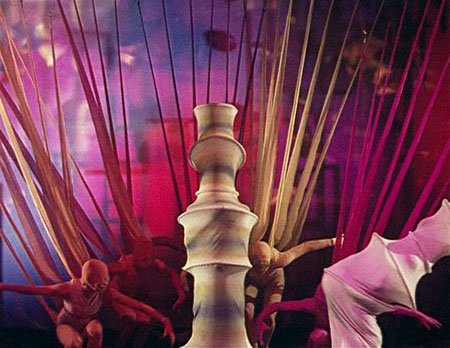
DIRECTED BY: Michael Haneke
FEATURING: Christian Friedel, Burghart Klaußner, Leonie Benesch, Maria-Victoria Dragus, Leonard Proxauf
PLOT: A doctor’s horse is tripped by a wire strung between two trees, and soon

other unexplained “accidents” start happening around a German village on the eve of WWI.
WHY IT WON’T MAKE THE LIST: I wouldn’t have even considered covering this fairly conventional film in this sacred space devoted to weirdness, except that as I was leaving the theater, I heard an old man ask the old woman beside him, “Wasn’t that the strangest movie you ever saw?” The old woman agreed. My initial reaction was sadness at the thought that they both had reached an advanced state of decrepitude without having ever witnessed the miracle of a truly strange film. My second thought was, I have to get out there and nip this rumor in the bud.
COMMENTS: As a historical drama, a novelistic examination of small town immorality, The White Ribbon is superb. It immerses us in the life of a quiet, one-bicycle German hamlet on the eve of World War I, where order is harshly enforced in public but cruelty and hypocrisy are the rule behind closed doors. The story begins by evoking a mystery—who strung the invisible steel wire that tripped the doctor’s horse?—then moves on to explore various village subplots involving characters from every strata of society. Among others, there’s the humane schoolteacher who romances a shy nanny; the Baron, who employs half the village and acts as if feudalism is still in fashion; a Farmer and the rebellious son who blames the Baron for his mother’s death; the Doctor, an eminent man hiding shameful secrets; the Midwife, who lives with the Doctor since his wife dies and cares for her mentally retarded son; and most significantly the Pastor, who is obsessed with enforcing purity among his children, binding his son’s arms at night to help him resist the temptation to touch himself and tying white ribbons on the elder children to remind them of innocence. And there are the children themselves, whose eerily blank faces and frustratingly proper responses to interrogations mask unknown motives. Led by creepy and unflappable Maria-Victoria Dragus, a gang of tykes seem to be present at the periphery of all the tragic accidents that start popping up around the village. The question of whether the kids are just curious spectators drawn to the hubub in a quiet town, or if they have some deeper involvement in the plague of catastrophes, is the mystery that Haneke leaves unsolved. But the real unsolved mystery may be why the director chose to structure his story as an unsolved mystery. When the tale focuses on exploring of moral hypocrisy, exposing the domestic cruelty of upstanding pillars of the community, the film is first-rate drama; there are excellent, tense scenes where a man callously dumps his mistress and parents inflict sadistic punishments on their children for minor infractions. Haneke apparently did not feel that this searing drama was enough to grant his film Palme d’Or-type gravitas, and so we have the ambiguous mystery arbitrarily piled on top. Not only is the plot obscure, but the purpose of employing an obscure plot is obscure.
Perhaps it’s because Haneke’s thesis isn’t as meaty as it seems. The reminders that these wan, detached and abused children will be the generation that grows up to embrace Nazism are not subtle. But if Haneke’s trying to say that a morally rigid, patriarchal society set the ground for the rise of Nazism… well, that’s a small part of the puzzle. But the same types of societies existed all over the Western world. Change a few details—replace the feudal Baron with a capitalist robber baron—and the story could just as easily be set in small town America in the 1910s. What’s specifically German about this story that supposedly helps to explain the rise of Nazism (as the film’s narrator suggests in his opening lines)? If, on the other hand, Haneke isn’t blaming a particular social order for nurturing fascism, but trying to say something universal about human societies and their capacity for institutional evil, the point gets a bit lost by locating the story in such an incredibly specific historical time and place. The movie ends up perched uncomfortably between ambiguity and a definite argument, between a universal message and a historical one. Maybe these unresolved tensions help explain why The White Ribbon, with its impeccable acting and classic production, feels thematically awkward.
WHAT THE CRITICS SAY:




